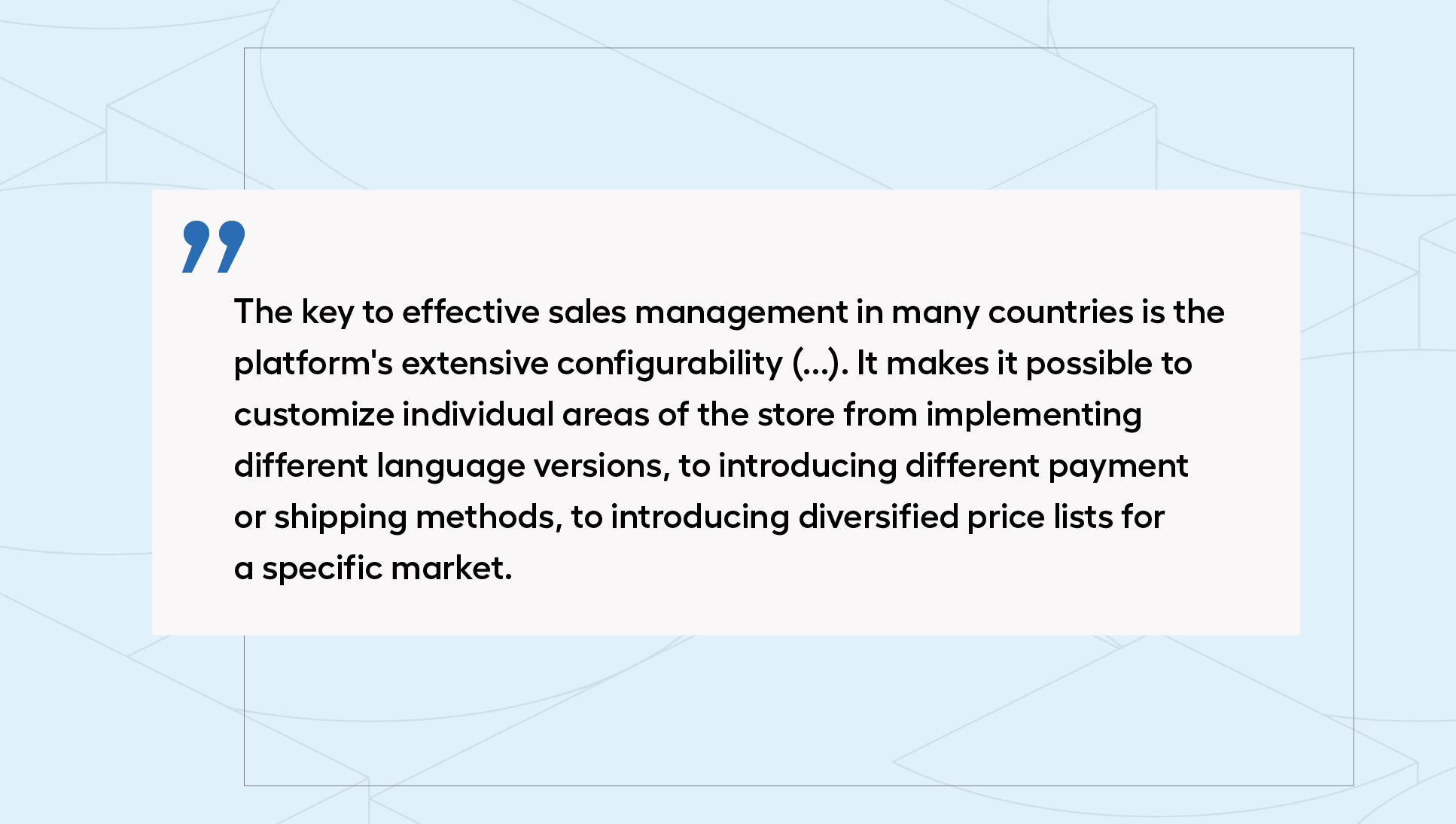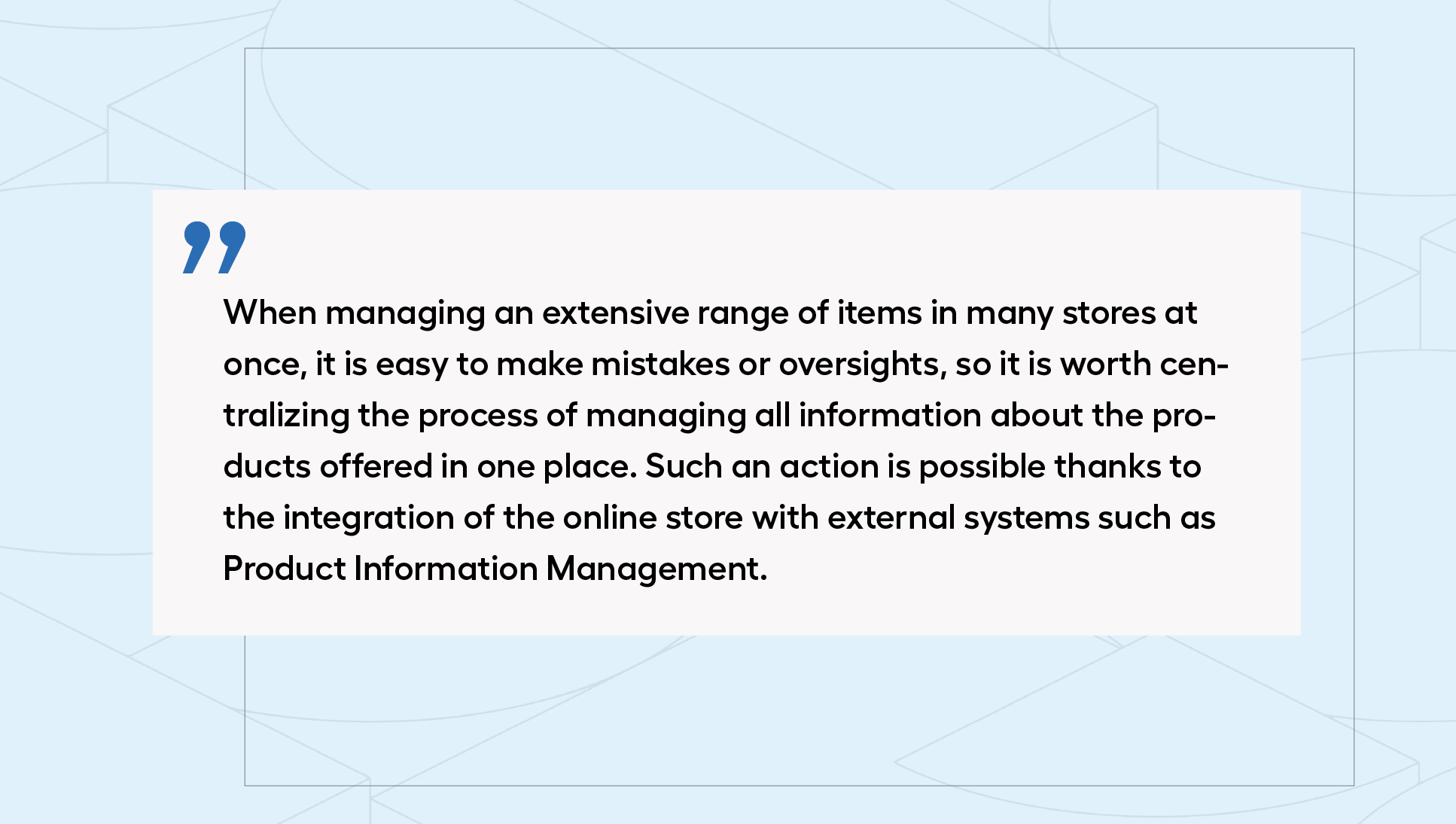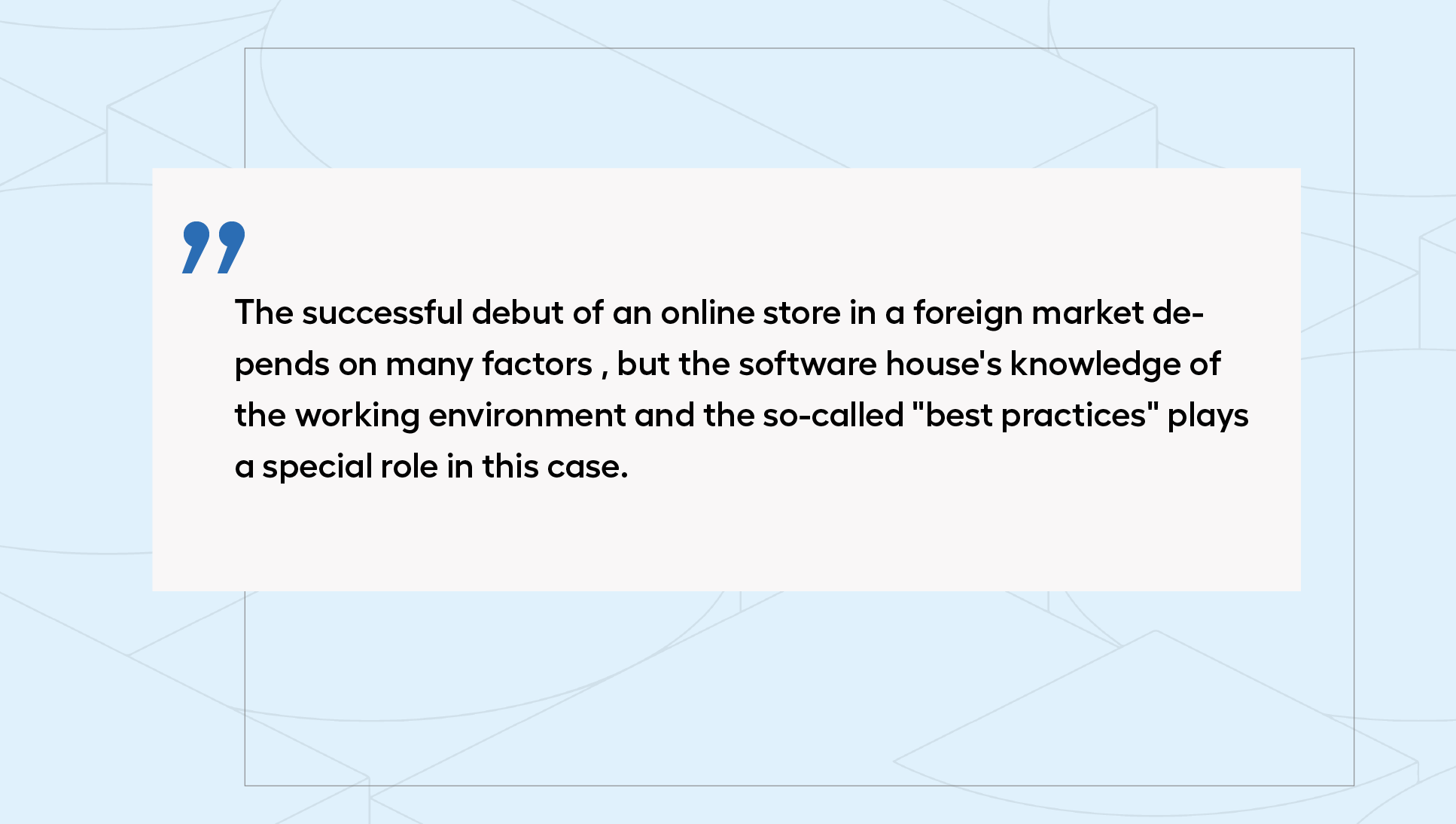A technical look at foreign sales. Talking about cross border commerce part V
You have already become well acquainted with the market where you intend to start selling. You know how the competitors there operate. You are aware of what organizational changes you need to make in your own company. And finally - you are no stranger to issues related to international logistics and payment systems. Does this mean that you are fully ready to make a successful debut in cross border commerce? Not quite. Among other things, you still have to choose the right eCommerce platform that will meet the needs of foreign trade. Paweł Podjacki, Senior Project Manager at ADVOX Studio, talks about which solutions to opt for and what to pay attention to when working with a software house. We invite you to read the next interview in the series devoted to foreign expansion in eCommerce.
Find out what else you should pay attention to in order to succeed in cross border commerce
- Cross border commerce talks part I. Competition analysis with Dealavo
- Cross border commerce talks part II. Work organization in international eCommerce - an interview with Jarosław Uczkiewicz
- Talking about cross border commerce part III. Cross-border sales through the eyes of logistics company Arvato
- Talking about cross border commerce part IV. How do foreign e-consumers pay - an interview with tPay
Rafal Gadomski: How to prepare your eCommerce for overseas expansion from the technical side? Is it necessary to design the entire platform from scratch?
Paweł Podjacki: When developing an overseas eCommerce strategy, one should not forget how important it is to choose the right sales platform - it should, first of all, be flexible to respond to the different needs of the markets, as well as allow for future business development. You should also take care of its stability (a matter of both platform performance and an optimally selected and configured server) and security. In crossborder sales, it is also equally important to efficiently manage multiple versions of stores and to be able to adapt their functionality to the specifics of the selected market.
RG: How to take care of effective management of multiple versions of the store simultaneously in practice?
PP: The key to effective sales management in many countries is the platform's wide configurability, which is provided, among other things, by the Multistore functionality offered by the Adobe Commerce (formerly Magento) engine. Thanks to it, it is possible to customize individual areas of the store from implementing different language versions, to introducing different payment or shipping methods, to introducing diversified price lists for a specific market. In this way, you can ensure that your offer is tailored to the expectations of foreign customers, for example, by being able to customize the description, payment methods or even the graphic design.

What's more, the number of domains supported within a single panel is unlimited, allowing expansion to scale as desired. The eCommerce owner can decide whether he wants to test one market first, or open his store right away in a couple of countries. The Multistore module can also prove useful for companies that manage many different brands or products - this way they can easily present the assortment on separate websites, while easily managing the entire offer. Such a solution can work, therefore, not only for overseas expansion, but also for diversification of one's business in the country, if only by introducing a separate domain ("website") for the B2B platform.
RG: In addition to the above-mentioned issues, the difficulty in managing foreign versions of eCommerce can also be caused by the handling of many diverse products - how to maintain control over the offerings in each version of the e-store?
PP: That's right - crossborder selling requires smoothly navigating not only between multiple products at once, but also maintaining consistent information in multiple languages. In such an environment, it's easy to make mistakes or oversights, so it makes sense to centralize the process of managing all the information about the products on offer in one place. Such an action is possible thanks to the integration of an online store with external systems such as Product Information Management (PIM for short), the purpose of which is precisely to manage product information. This type of software allows you to be sure that the information about items in each sales channel will be complete and up-to-date, and if there are changes - there will be an automatic update of the content. This kind of content management allows not only to minimize errors and mistakes, reduce time-to-market (by making all information available at once on all platforms), but also to personalize the offer in a better way, taking into account the requirements of local users, or, finally, to improve product management processes within the organization.

RG: We already know how to manage products on a foreign platform - could you zoom in on how to adapt the platform for international payment processing, including currency conversion issues?
PP: Starting with the discussion of payments - it is worth paying attention to whether the platform we choose allows integration with various payment systems and methods. Nowadays, just looking at European markets, one can often see dramatic differences in customers' expectations of preferred payment methods. For example, in the western part of the continent, deferred payments are already standard, in the UK customers are exceptionally eager to pay with a wallet provided by Apple. In Scandinavian countries, on the other hand, card payments dominate. By integrating with the most desirable payment methods, we increase the customer's trust and the chance that they will complete the transaction. Tailoring to the specifics of the country and the profiles of the customers there is also facilitated by the adaptation of the level and pricing policy to specific markets - a function that proves to be particularly important now, at a time when the economies of countries are going through smaller or larger crises.
In addition, Magento offers options to automate currency conversion issues, further meeting the expectations of buyers in the "new" market. Among other things, the e-store owner has the ability to set a default currency for a given version of the platform and automatically convert currencies based on exchange rates, which are collected from various sources, such as websites and banks. The system converts prices to local currency on its own, and customers can make purchases in their own currency from the start. If the store requires more precise control over the exchange rates (for example, due to the specifics of the products sold or unfavorable and unstable economic situation) there is also an option to manually change the exchange rate and convert prices.
RG: How, on the other hand, are the logistical issues shaping up? Is it also possible to automate them by properly designing the platform from the technical side?
PP: Undoubtedly, logistics, as well as payments, occupy a special place in eCommerce (a positive purchase decision often depends on them). Thus, taking logistics aspects into account when designing an online store website is not only possible, but also necessary. Platforms available on the market offer many ready-made modules that, when integrated with eCommerce, allow efficient contact with courier companies (e.g. automatically generating waybills) or ongoing tracking of shipments.
The above issues largely affect customer comfort and satisfaction - when planning logistics, it is also equally important to pay attention to customs and tax issues. Each country is characterized by different laws, and compliance with them is essential to run an e-business without risking a violation of the applicable rules. Therefore, when choosing a platform, it is also important to pay attention to whether it allows you to configure tax rates and the amount of customs duties (or lack thereof) depending on the region. For example, Magento 2 allows you to automatically calculate and collect the appropriate amount of duties depending on the direction of expansion.
RG: We know from previous parts of the series that eCommerce owners often (especially at the beginning of their overseas operations) choose to have a presence on marketplaces popular in their country. How do you combine this channel with selling on your own platform?
PP: Integrating an in-house sales platform with a marketplace most often requires the use of appropriate extensions, followed by their configuration and the synchronization of products in both channels via an API. In such a way, it is possible to both effectively sell and monitor the level of sales and other data related to completed transactions, allowing easy management and maximization of profits in each channel.
As for specific marketplaces - globally in Europe Amazon reigns supreme, followed by eBay. In addition, virtually every country has a local leader among such platforms. For example, in the UK ASOS stands out, and in Germany Zalando.
RG: How important is a software house's experience in developing online stores in selected markets to the success of a project?
PP: A successful debut of an online store on a foreign market depends on many factors (e.g. compatibility of the offer with consumer expectations, local trends or the current economic situation), but the software house's knowledge of the working environment plays a special role in this case. Knowledge of the so-called "best practices" helps avoid many mistakes, but also translates into increasing the competitiveness of the store by introducing solutions unknown in the agency's home market.

Working on international projects allows you to recognize the nuances that can affect the success of an e-store in the future. Foreign customers often have a different sense of aesthetics or shopping habits. Awareness of these differences allows you to design the UX of your store in accordance with their expectations - without the application of such knowledge, it could turn out that even the most efficient and optimized website will not be fully useful to its target audience. On the same note, the aforementioned knowledge of the most popular payment and delivery methods in the regions, or even an awareness of what is the acceptable waiting time for a page to load, will also be useful. In addition, the experience you have translates strictly into speeding up the work on the project, as you can use and modify previously developed modules to suit your needs.
RG: And what if the working hours of the software house differ from the client's hours of availability due to a different time zone. What to ask the agency in such a case?
PP: Developing a common position between the agency and the client on this issue is particularly important when entering into service level agreements (SLAs). In case of differences in time zones, the first thing to do is to establish the hourly interval within which the company should respond to reports of failures or other problems. Also not to be overlooked is a precise definition of the means of communication, the responsibilities of both parties, as well as reporting rules and contingency plans for any irregularities.
In addition to the SLA, applied to the care of the store after its launch, it is important to keep in mind the cooperation between the Agency and the Client at the stage of implementation of the store. In this case, it will be particularly important to organize the work of the team and work closely with the Project Manager dedicated to the project on the one hand and the Product Owner on the other. Even with time differences of 8-9h, it is possible to work out rules that allow the work to be carried out smoothly and take into account feedback from the client.
In summary, it is important that the SLA includes precise arrangements for response times, means of communication, responsibilities, troubleshooting procedures, monitoring of system performance system, contingency plans, uptime and data protection. In this way, misunderstandings can be avoided and smooth cooperation with the IT agency can be ensured, even if it works in a different time zone.
Design a sales platform with crossborder commerce in mind
The eCommerce platform is usually responsible for the first impression of your online store. Especially when debuting in a new market, it is worth bearing in mind that with an efficient and intuitive interface, users will find it easier to find the necessary product information and make orders. For foreign buyers, it will be important not only that the site is maintained in their language (that's basic), but also that the solutions used on it are tailored to their habits. Choosing the right software is also an advantage for you as an e-store owner. Why? Because it allows you to more easily manage orders, payments, shipments and monitor sales in real time from a single administration panel.
All of these elements can contribute to the success of online sales in international markets, and a software house with foreign experience can help you design and implement them properly. If you are curious about what international projects, we have completed as Advox then take a look at our case studies. Maybe you will find inspiration to start the adventure of crossborder commerce in your business?



